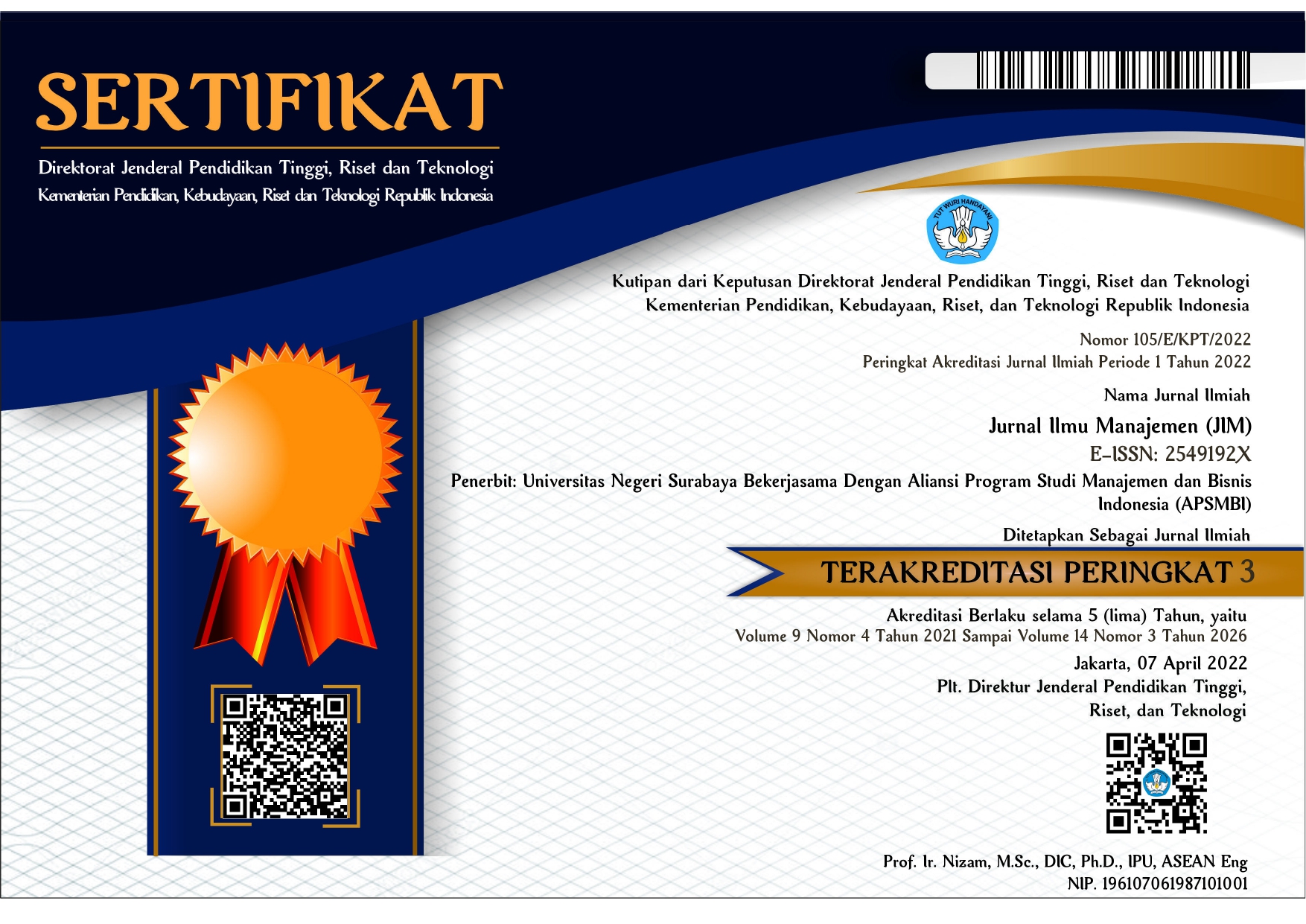Integrasi Health Belief Model dan Theory of Planned Behavior untuk Memprediksi Niat Konsumsi Produk Rendah Gula pada Mahasiswa
DOI:
https://doi.org/10.26740/jim.v13n3.p565–580Keywords:
consumption intention, health belief model, health motivation, low-sugar consumption, theory of planned behaviorAbstract
This study examines the effects of perceived benefits, perceived barriers, and health motivation on attitudes, and the subsequent influence of attitudes on the intention to consume low-sugar products among students at Universitas Hasyim Asy’ari, Jombang, Indonesia. Integrating the Health Belief Model (HBM) and the Theory of Planned Behavior (TPB), this explanatory quantitative research applies Partial Least Squares Structural Equation Modeling (PLS-SEM) to data collected from 100 purposively selected students. The analysis reveals that perceived benefits and health motivation significantly and positively affect attitudes, while perceived barriers show no significant influence. Attitudes emerge as the main predictor of the intention to adopt low-sugar consumption behaviors. Theoretically, these findings strengthen the understanding that intrinsic motivation and perceived benefits can overcome external barriers in shaping health intentions, especially within a collectivist cultural context. Practically, the study highlights the importance of participatory, value-driven social marketing campaigns that resonate with students’ emotional, moral, and social values. Effective interventions should not rely solely on rational health information but also engage young audiences through relatable narratives, role models, and community-based approaches. Overall, this research offers both theoretical insights and practical recommendations for designing culturally sensitive strategies to promote sustainable healthy consumption behaviors among youth in developing countries.
References
Ahsan, A. (2025). The correlation of caloric intake from sugar-sweetened beverage (SSB) on type 2 diabetes mellitus (T2DM) risk in Indonesia. Social Science.
Ajzen, I. (1991). The theory of planned behavior. Organizational Behavior and Human Decision Processes, 50(2), 179–211. https://doi.org/10.1016/0749-5978(91)90020-T
Ajzen, I., & Fishbein, M. (1980). Understanding Attitudes and Predicting Social Behavior. Prentice Hall.
Ali, M. H., Ningsih, L. S. R., Santoso, R. P., Laili, C. N., Ardiana, M., & Thahirrah, N. N. (2024). Green Experiential Marketing Dalam Meningkatkan Loyalitas Pelanggan Pada Bisnis Coffee Shop (Studi Pada Kedai Kopi Ramah Lingkungan Se-Kabupaten Jombang). Journal of Science and Social Research, 7(4).
Ali, M. H., Ningsih, L. S. R., Santoso, R. P., Laili, C. N., Ardiana, M., & Thahirrah, N. N. (2025). Green Experiential Marketing: Strategi Inovatif untuk Membangun Loyalitas dan Keberlanjutan. LPPM UNHASY.
Allom, V., Mullan, B., Cowie, E., & Hamilton, K. (2016). Physical activity and transitioning to college: The importance of intentions and habits. American Journal of Health Behavior, 40(2), 280–290. https://doi.org/10.5993/AJHB.40.2.13
Amerzadeh, M. (2024). Self-care behaviors, medication adherence status, and associated factors among elderly individuals with type 2 diabetes. Scientific Reports.
Andini, N. P., Kurniawan, T., Pratiwi, S. H., & Nursiswati, N. (2024). TINGKAT RISIKO DIABETES MELITUS TIPE 2 PADA MAHASISWA FAKULTAS KEPERAWATAN. Jurnal Ilmiah Kesehatan Keperawatan, 20(2), 64. https://doi.org/10.26753/jikk.v20i2.1370
Ateş, H., Demir Özdenk, G., & Çalışkan, C. (2021). DETERMINANTS OF SCIENCE TEACHERS’ HEALTHY EATING BEHAVIORS: COMBINING HEALTH BELIEF MODEL AND THEORY OF PLANNED BEHAVIOR. Journal of Baltic Science Education, 20(4), 573–589. https://doi.org/10.33225/jbse/21.20.573
Atmarita, Nelis Imanningsih, Abas B Jahari, Ir Dewi Permaesih, Pauline Chan, & Maria Sofia Amarra. (2018). Consumption and sources of added sugar in Indonesia: A review. Asia Pacific Journal of Clinical Nutrition, 27(1). https://doi.org/10.6133/apjcn.042017.07
Baldemor, R. V. V., Ong, A. K. S., German, J. D., Bautista, N. S., Alonso, M. L. V., & Alidio, O. J. P. (2024). Health Belief and Behavioral Analysis of Fad Diets: A Perspective from Younger Generations in a Developing Country. Foods, 13(12), 1858. https://doi.org/10.3390/foods13121858
Biasini, B., Rosi, A., Scazzina, F., & Menozzi, D. (2023). Predicting the Adoption of a Sustainable Diet in Adults: A Cross-Sectional Study in Italy. Nutrients, 15(12), 2784. https://doi.org/10.3390/nu15122784
BPS Jatim. (2023). Analisis Data Gula Provinsi Jawa Timur 2022. BPS Provinsi Jawa Timur. https://jatim.bps.go.id
Brennan, L., Klassen, K., Weng, E., Chin, S., Molenaar, A., Reid, M., Truby, H., & McCaffrey, T. A. (2020). A social marketing perspective of young adults’ concepts of eating for health: Is it a question of morality? International Journal of Behavioral Nutrition and Physical Activity, 17(1), 44. https://doi.org/10.1186/s12966-020-00946-3
Chan, K., & Tsang, L. (2011). Promote healthy eating among adolescents: A Hong Kong study. Journal of Consumer Marketing, 28(5), 354–362. https://doi.org/10.1108/07363761111150008
Deshpande, S., Basil, M. D., & Basil, D. Z. (2009). Factors Influencing Healthy Eating Habits Among College Students: An Application of the Health Belief Model. Health Marketing Quarterly, 26(2), 145–164. https://doi.org/10.1080/07359680802619834
Du, L., & Jiang, S. (2025). Enhancing Green Food Consumption Intentions Among Chinese Generation X: Integrating Environmental Values and Self-Identity into the Theory of Planned Behavior. Sustainability, 17(7), 2942. https://doi.org/10.3390/su17072942
Espeño, P. R., Ong, A. K. S., German, J. D., Gumasing, Ma. J. J., & Casas, E. S. (2024). Analysis of Actual Fitness Supplement Consumption among Health and Fitness Enthusiasts. Foods, 13(9), 1424. https://doi.org/10.3390/foods13091424
Fishbein, M., & Ajzen, I. (1975). Belief, Attitude, Intention, and Behavior: An Introduction to Theory and Research. Addison-Wesley.
Fishbein, M., & Ajzen, I. (2010). Predicting and Changing Behavior: The Reasoned Action Approach. Psychology Press, Taylor & Francis Group. https://doi.org/10.4324/9780203838020
Fishbein, M., & Cappella, J. N. (2006). The Role of Theory in Developing Effective Health Communications. Journal of Communication, 56(suppl_1), S1–S17. https://doi.org/10.1111/j.1460-2466.2006.00280.x
Glanz, K., Rimer, B. K., & Viswanath, K. (Ed.). (2015). Health behavior: Theory, research, and practice (Fifth edition). Jossey-Bass.
Grønhøj, A., Bech‐Larsen, T., Chan, K., & Tsang, L. (2012). Using theory of planned behavior to predict healthy eating among Danish adolescents. Health Education, 113(1), 4–17. https://doi.org/10.1108/09654281311293600
Hagger, M. S., & Hamilton, K. (2024). Longitudinal tests of the theory of planned behaviour: A meta-analysis. European Review of Social Psychology, 35(1), 198–254. https://doi.org/10.1080/10463283.2023.2225897
Hair, J. F., Hult, G. T. M., Ringle, C., & Sarstedt, M. (2019). A Primer on Partial Least Squares Structural Equation Modeling (PLS-SEM) (2nd ed.). Sage Publications.
Hazmi, T. M. A., lghamdi, A., & Abdulmajeed, I. (2018). Eating Habits among Healthcare Providers during Working Hours at National Guard Health Affairs-Riyadh, Saudi Arabia.
Hochbaum, G. M. (1958). Public Participation in Medical Screening Programs: A Socio-Psychological Study. U.S. Department of Health, Education, and Welfare, Public Health Service. https://stacks.cdc.gov/view/cdc/11125
IDF. (2025a). IDF Diabetes Atlas: 11th Edition. International Diabetes Federation. https://diabetesatlas.org
IDF. (2025b). IDF Diabetes Atlas 11th Edition 2025—South-East Asia Factsheet. https://diabetesatlas.org
Jezewska-Zychowicz, M., & Plichta, M. (2022). Diet Quality, Dieting, Attitudes and Nutrition Knowledge: Their Relationship in Polish Young Adults—A Cross-Sectional Study. International Journal of Environmental Research and Public Health, 19(11), 6533. https://doi.org/10.3390/ijerph19116533
Jiang, N., Chen, J., Cao, H., Liu, Y., Zhang, Y., Wang, Q., Wang, T., Zhao, H., Lu, H., Yang, L., & Wang, J. (2022). Parents’ intentions toward preschool children’s myopia preventive behaviors: Combining the health belief model and the theory of planned behavior. Frontiers in Public Health, 10, 1036929. https://doi.org/10.3389/fpubh.2022.1036929
Joung, H.-W. D., Choi, E. K. C., Ahn, J., & Kim, H.-S. (2014). Healthy Food Awareness, Behavioral Intention, and Actual Behavior toward Healthy Foods: Generation Y Consumers at University Foodservice. Journal of the Korean Society of Food Culture, 29(4), 336–341. https://doi.org/10.7318/KJFC/2014.29.4.336
Kemenkes RI. (2018). Laporan Nasional Riskesdas 2018. Lembaga Penerbit Badan Penelitian dan Pengembangan Kesehatan. https://repository.badankebijakan.kemkes.go.id/id/eprint/3514/1/Laporan%20Riskesdas%202018%20Nasional.pdf
Kemenkes RI. (2021). Profil Diabetes di Indonesia. Kementerian Kesehatan RI. https://kesmas.kemkes.go.id/assets/upload/dir_519d41d8cd98f00/files/Hasil-riskesdas-2018_1274.pdf
Kothe, E., & Mullan, B. (2012). Acceptability of a theory of planned behaviour email-based nutrition intervention. Health promotion international, 29. https://doi.org/10.1093/heapro/das043
Kotler, P., & Zaltman, G. (1971). Social Marketing: An Approach to Planned Social Change. Journal of Marketing, 35(3), 3–12. https://doi.org/10.1177/002224297103500302
Lee, N. R., & Kotler, P. (2020). Social Marketing: Behavior Change for Social Good (6th ed.). SAGE Publications. https://us.sagepub.com/en-us/nam/social-marketing/book256989
Maranata, Rivatunisa, C., Wahyu Noviyanti, K., & Romia. (2024). Pengaruh Aksesibilitas Teknologi Informasi terhadap Pengetahuan tentang Diabetes Mellitus pada Mahasiswa Politeknik Piksi Ganesha. LAMBDA : Jurnal Ilmiah Pendidikan MIPA dan Aplikasinya, 4(2), 127–134. https://doi.org/10.58218/lambda.v4i2.968
Marks, D. F., Murray, M., & Estacio, E. V. (2018). Health Psychology: Theory, Research and Practice (5th ed.). SAGE Publications Ltd. https://study.sagepub.com/marks5e
Mohammadkhah, F., Kamyab, A., Pezeshki, B., Norouzrajabi, S., & Khani Jeihooni, A. (2025). The effect of training intervention based on health belief model on self-care behaviors of women with gestational diabetes mellitus. Frontiers in Global Women’s Health, 5, 1490754. https://doi.org/10.3389/fgwh.2024.1490754
Nagar, K. (2020). An Examination of Gym Supplement Choice: Using the Modified Theory of Planned Behaviour. Journal of Food Products Marketing, 26(7), 499–520. https://doi.org/10.1080/10454446.2020.1817827
Nurita, D. R., & Yulistiani, M. (2024). Penilaian Tingkat Risiko Sebagai Prediksi Angka Kejadian Diabetes Melitus Tipe 2 Pada Mahasiswa Keperawatan S1 Universitas Muhammadiyah Purwokerto Dalam Waktu 10 Tahun Kedepan. Jurnal Ilmiah Wahana Pendidikan, 10(4), 192–195. https://doi.org/10.5281/zenodo.10512157
Ohnmacht, T., Hüsser, A. P., & Thao, V. T. (2022). Pointers to Interventions for Promoting COVID-19 Protective Measures in Tourism: A Modelling Approach Using Domain-Specific Risk-Taking Scale, Theory of Planned Behaviour, and Health Belief Model. Frontiers in Psychology, 13, 940090. https://doi.org/10.3389/fpsyg.2022.940090
Patwary, M. M., Disha, A. S., Hasan, M., Bardhan, M., Hasan, M., Tuhi, F. I., Rahim, S. J., Newaz, Md. N., Imran, S. A., Haque, Md. Z., Hossain, Md. R., Kabir, M. P., & Swed, S. (2023). Integrating health belief model and theory of planned behavior to assess COVID-19 vaccine acceptance among urban slum people in Bangladesh. PLOS ONE, 18(12), e0290412. https://doi.org/10.1371/journal.pone.0290412
Poínhos, R., van der Lans, I. A., Rankin, A., Fischer, A. R. H., Bunting, B., Kuznesof, S., Stewart-Knox, B., & Frewer, L. J. (2014). Psychological determinants of consumer acceptance of personalised nutrition in 9 European countries. PloS One, 9(10), e110614. https://doi.org/10.1371/journal.pone.0110614
Povey, R., Conner, M., Sparks, P., James, R., & Shepherd, R. (2000). The theory of planned behaviour and healthy eating: Examining additive and moderating effects of social influence variables. Psychology & Health, 14(6), 991–1006. https://doi.org/10.1080/08870440008407363
Rosalina, W. (2024a, Juni 9). Jumlah Penderita Diabetes di Jombang Capai Puluhan Ribu, di Antaranya Anak Usia 15 Tahun, Segini Rinciannya—Jombang Banget. Jumlah Penderita Diabetes di Jombang Capai Puluhan Ribu, di Antaranya Anak Usia 15 Tahun, Segini Rinciannya - Jombang Banget. https://jombangbanget.jawapos.com/kesehatan/2134740144/jumlah-penderita-diabetes-di-jombang-capai-puluhan-ribu-di-antaranya-anak-usia-15-tahun-segini-rinciannya
Rosalina, W. (2024b, Juni 9). Waduh! Angka Penderita Diabetes dan Hipertensi Melonjak di Jombang, Ini Beberapa Penyebab Utamanya—Radar Jombang. Waduh! Angka Penderita Diabetes dan Hipertensi Melonjak di Jombang, Ini Beberapa Penyebab Utamanya - Radar Jombang. https://radarjombang.jawapos.com/berita-daerah/664740145/waduh-angka-penderita-diabetes-dan-hipertensi-melonjak-di-jombang-ini-beberapa-penyebab-utamanya
Rosenstock, I. M. (1974). The Health Belief Model and Preventive Health Behavior. Health Education Monographs, 2(4), 354–386. https://doi.org/10.1177/109019817400200405
Salahshoori, A., Sharifirad, G., Hassanzadeh, A., & Mostafavi, F. (2014). An assessment of the role of perceived benefits, barriers and self-efficacy in predicting dietary behavior in male and female high school students in the city of Izeh, Iran. Journal of Education and Health Promotion, 3, 8. https://doi.org/10.4103/2277-9531.127558
Sanaji, S., Handriana, T., & Usman, I. (2023). Antecedents and consequences of value co-creation in online shopping. BISMA (Bisnis Dan Manajemen), 15(1), 20–39. https://doi.org/10.26740/bisma.v15n1.p20-39
Strecher, V. J., & Rosenstock, I. M. (1997). The Health Belief Model. Dalam K. Glanz, F. M. Lewis, & B. K. Rimer (Ed.), Health Behavior and Health Education: Theory, Research, and Practice (hlm. 41–59). Jossey-Bass.
Sun, Y.-H. C. (2008). Health concern, food choice motives, and attitudes toward healthy eating: The mediating role of food choice motives. Appetite, 51(1), 42–49. https://doi.org/10.1016/j.appet.2007.11.004
Wang, Y., Wen, X., Zhu, Y., Xiong, Y., & Liu, X. (2022). Chinese Residents’ Healthy Eating Intentions and Behaviors: Based on an Extended Health Belief Model. International Journal of Environmental Research and Public Health, 19(15), Article 15. https://doi.org/10.3390/ijerph19159037
Xu, H., Xiao, M., Zeng, J., & Hao, H. (2022). Green-Labelled Rice versus Conventional Rice: Perception and Emotion of Chinese Consumers Based on Review Mining. Foods, 12(1), 87. https://doi.org/10.3390/foods12010087
Yang, Q., Xinyue, L., Hoque, M. E., Mamun, A. A., Rahman, M. K., & Yao, J. (2023). Modelling the mass consumption potential of organic food: Evidence from an emerging economy. PLOS ONE, 18(9), e0291089. https://doi.org/10.1371/journal.pone.0291089
Yazdanpanah, L., Nasiri, M., & Adarvishi, S. (2015). Literature review on the management of diabetic foot ulcer. World Journal of Diabetes, 6(1), 37–53. https://doi.org/10.4239/wjd.v6.i1.37
Yeboah, P., Abdin, A. Y., Gyasi, T. O., Anyimiah, P., Osafo, N., Skotzke, P., Pitsch, W., Brobbey, M. O., Panyin, A. B., Razouk, A., Nasim, M. J., & Jacob, C. (2025). Informed but Unvaccinated: A Cross-Sectional Study Among University Students in Ghana. COVID, 5(4), 47. https://doi.org/10.3390/covid5040047
Zaitoon, H., Kaly, L., Khalil, H., & Zion, N. (2024). Balancing Knowledge and Health: A Comparative Analysis of Students and Healthcare Workers Nutrition Related Health Behaviors, a Cross‐Sectional Study. Nursing & Health Sciences, 26(4), e70000. https://doi.org/10.1111/nhs.70000
Zhou, B., Rayner, A. W., Gregg, E. W., Sheffer, K. E., Carrillo-Larco, R. M., Bennett, J. E., Shaw, J. E., Paciorek, C. J., Singleton, R. K., Barradas Pires, A., Stevens, G. A., Danaei, G., Lhoste, V. P., Phelps, N. H., Heap, R. A., Jain, L., D’Ailhaud De Brisis, Y., Galeazzi, A., Kengne, A. P., … Ezzati, M. (2024). Worldwide trends in diabetes prevalence and treatment from 1990 to 2022: A pooled analysis of 1108 population-representative studies with 141 million participants. The Lancet, 404(10467), 2077–2093. https://doi.org/10.1016/S0140-6736(24)02317-1
Zhou, Y., Liu, L., Han, S., & Sun, X. (2023). Comparative analysis of the behavioral intention of potential wellness tourists in China and South Korea. Humanities and Social Sciences Communications, 10(1), 1–13. https://doi.org/10.1057/s41599-023-01997-0
Zoellner, J., Estabrooks, P., Davy, B., Chen, Y., & You, W. (2012). Exploring the Theory of Planned Behavior to Explain Sugar-Sweetened Beverage Consumption. Journal of Nutrition Education and Behavior, 44(2), 172–177. https://doi.org/10.1016/j.jneb.2011.06.010
Downloads
Published
How to Cite
Issue
Section
License

This work is licensed under a Creative Commons Attribution-NonCommercial 4.0 International License.
 Abstract views: 289
,
Abstract views: 289
, PDF Downloads: 217
PDF Downloads: 217











